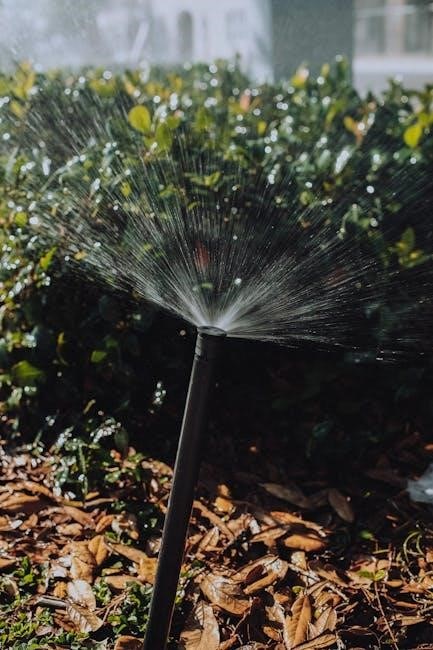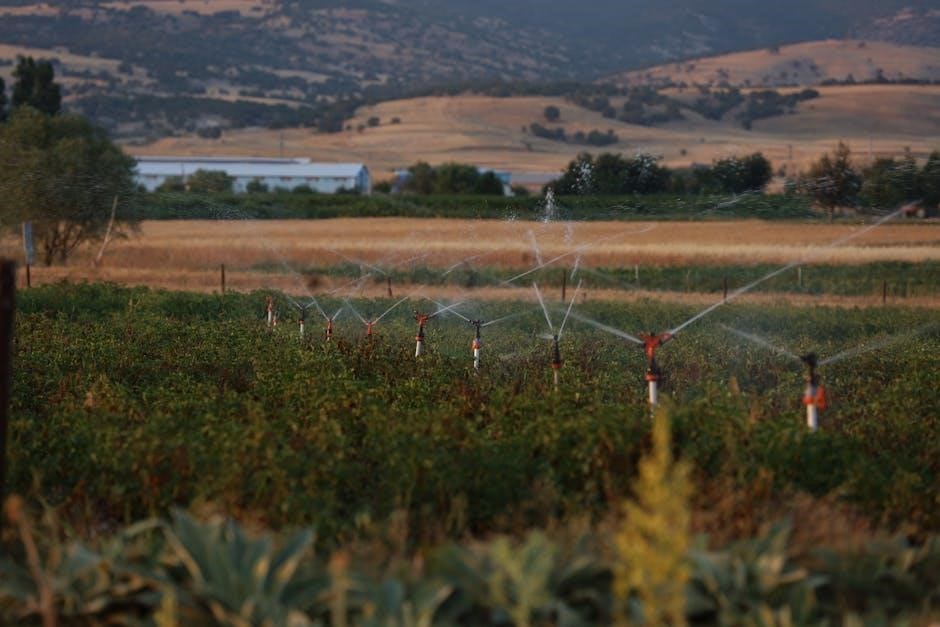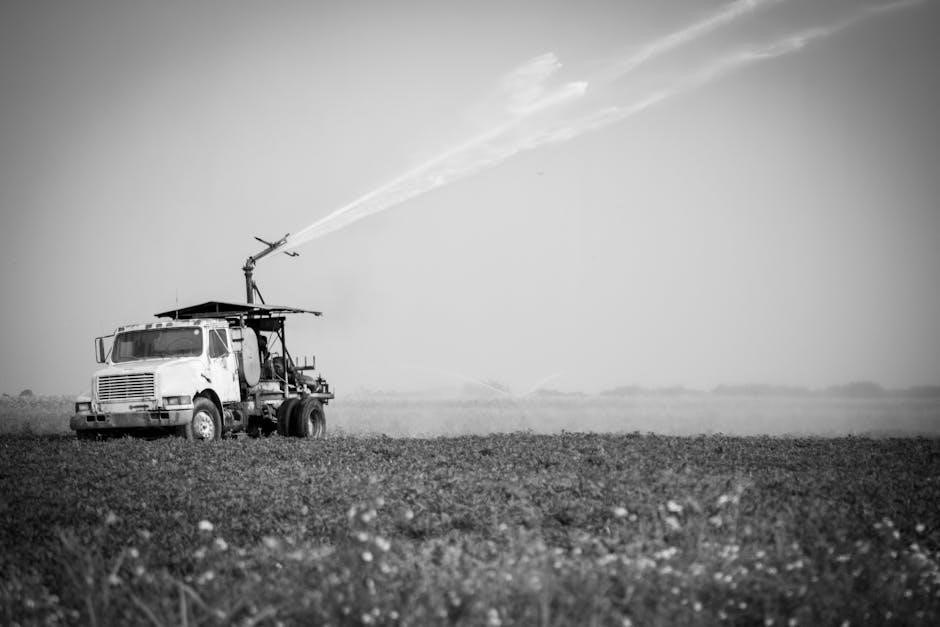A sprinkler irrigation system is an efficient and versatile method of water distribution, simulating natural rainfall. It is widely used in both agricultural and residential settings.
The system’s design ensures optimal water use, reduces evaporation, and enhances crop yields. Proper planning involves understanding components, water sources, and environmental factors like soil and climate.
1.1 Definition and Importance of Sprinkler Irrigation
Sprinkler irrigation is a water distribution method that mimics natural rainfall by delivering water through a network of sprinklers. It is highly efficient, reducing evaporation and runoff, and ensures uniform water application. This system is crucial for agriculture, residential landscaping, and environmental conservation, promoting healthy plant growth and water conservation while adapting to varying soil and climate conditions effectively.
1.2 Brief History and Evolution of Sprinkler Systems
The concept of sprinkler irrigation dates back to ancient civilizations, but modern systems emerged in the 20th century. Early systems were manual, while advancements in technology introduced automated and center-pivot irrigation in the 1950s. Over time, innovations like smart irrigation controllers and precision agriculture have enhanced efficiency, water conservation, and uniformity, making sprinkler systems indispensable in agriculture and landscaping.
Key Components of a Sprinkler Irrigation System
The system includes a pump, pipes, filters, sprinklers, and controllers. These components work together to deliver water efficiently, ensuring proper irrigation and minimizing waste.

2.1 Hydraulic and Mechanical Components
The hydraulic components include pumps, valves, and pipes, ensuring water flow and pressure. Mechanical parts like sprinkler heads and nozzles distribute water evenly. Proper sizing and selection of these elements are crucial for system efficiency and longevity, preventing clogging and wear, and ensuring uniform water distribution across the irrigated area.
2.2 Water Source and Filtration Systems
The water source is a critical component, often sourced from wells, rivers, or reservoirs. Filtration systems are essential to prevent clogging of sprinkler nozzles and ensure clean water delivery. Screen filters, sand separators, and media filters are commonly used, depending on water quality. Proper filtration extends system lifespan and maintains efficiency, ensuring optimal water distribution for crops or landscapes.
Design Considerations for Sprinkler Irrigation Systems
Designing a sprinkler system requires assessing soil type, climate conditions, and water availability. Proper planning ensures efficient water distribution, minimizing waste and maximizing crop health.
3.1 Soil and Climate Assessment
Soil type, texture, and water-holding capacity are critical in designing sprinkler systems. Climate factors like temperature, humidity, and rainfall patterns influence irrigation frequency and water application rates. Understanding these elements ensures optimal water distribution, preventing over-use or under-use. Soil moisture deficit management, such as maintaining a 50% Management Allowable Deficit (MAD), is essential for balancing water availability and crop needs efficiently.
3.2 Water Pressure and Flow Rate Requirements
Accurate calculation of water pressure and flow rate is crucial for efficient sprinkler system design. The precipitation rate, measured in inches per hour, must match the system’s capacity. Proper pressure ensures uniform water distribution, while flow rate determines the system’s ability to cover the entire area effectively. Balancing these factors ensures optimal irrigation performance and water resource management.

Sprinkler System Layout and Configuration
Sprinkler system layout and configuration involve arranging components to suit field conditions, including center pivot and solid set systems, ensuring proper water distribution and maximum coverage.
4.1 Field Shape and Topography
Field shape and topography significantly influence sprinkler system design. Circular fields are ideal for center pivot systems, while irregular shapes may require adjustable layouts. Sloped terrains demand precise nozzle placement to prevent water runoff and ensure uniform coverage. Proper configuration ensures efficient water distribution, adapting to the land’s natural contours for optimal irrigation performance and reduced water waste.
4.2 Sprinkler Spacing and Coverage Patterns
Sprinkler spacing and coverage patterns are critical for uniform water distribution. Proper spacing ensures even application, while coverage patterns like square, triangular, or circular layouts suit different field conditions. Precipitation rate and water pressure influence nozzle selection and spacing. Uniformity is key to preventing overwatering or dry spots, ensuring efficient irrigation and healthy plant growth across the entire field area.

Types of Sprinkler Irrigation Systems
Sprinkler irrigation systems are categorized into permanent, portable, and semi-permanent designs, each offering unique benefits for different applications and field conditions.
5.1 Permanent Systems
Permanent sprinkler systems are fixed installations with buried main and lateral lines, offering durability and long-term efficiency. They are ideal for large-scale agricultural fields and residential lawns, ensuring consistent water distribution. These systems minimize labor costs and are designed for high water pressure and flow rates, making them suitable for uniform topography and crops requiring precise irrigation. Examples include solid set and center pivot systems.
5.2 Portable Systems
Portable sprinkler systems are versatile and adaptable, suitable for small to medium-sized fields. These systems allow for easy repositioning, making them ideal for rotational irrigation. They are cost-effective and require minimal installation, often used in areas with varying crop needs or uneven terrain. Portable systems are perfect for farmers seeking flexibility and efficiency without the high investment of permanent setups.
Advantages of Sprinkler Irrigation Systems
The system ensures uniform water distribution, enhancing crop yields and reducing waste. It minimizes evaporation and runoff, promoting water conservation and efficient resource use.
6.1 Water Conservation and Efficiency
Sprinkler irrigation systems optimize water use by delivering it directly to plants, reducing runoff and evaporation. They allow precise control over application rates, minimizing waste. By ensuring even distribution, these systems align water delivery with soil needs, preventing overwatering. This targeted approach enhances water conservation, making it ideal for regions with limited water resources and varying soil types.
6.2 Crop Yield and Uniform Water Distribution
Uniform water distribution in sprinkler systems ensures consistent soil moisture, promoting healthy plant growth and higher crop yields. The precise application of water reduces variability in soil conditions, enhancing root development and nutrient uptake. This leads to improved crop health and productivity, making sprinkler irrigation a reliable method for maximizing agricultural output and ensuring optimal growing conditions.

Challenges and Limitations of Sprinkler Systems
Sprinkler systems face challenges such as high installation costs, regular maintenance needs, and potential issues like clogging and wear, requiring careful planning and upkeep.
7.1 High Initial Cost and Maintenance
The high initial cost of sprinkler systems includes equipment and installation expenses. Regular maintenance is essential to prevent clogging and wear, adding to long-term costs. Components like nozzles and filters require frequent checks and replacements, ensuring optimal performance. While these expenses can be significant, proper upkeep is crucial for system efficiency and longevity, making it a worthwhile investment for sustainable irrigation.
7.2 Potential for Clogging and Wear
Clogging and wear are common challenges in sprinkler systems, often caused by debris and sediment in water sources. Over time, nozzles and filters can become obstructed, reducing water flow and system efficiency. Regular cleaning and replacement of worn parts are necessary to maintain performance. Proper filtration systems and routine inspections can mitigate these issues, ensuring the longevity and effectiveness of the irrigation system.

Installation and Maintenance Tips
Proper installation ensures system efficiency, while regular maintenance prevents clogging and wear. Inspect and clean components frequently, and follow manufacturer guidelines for optimal performance and longevity.
8.1 Steps for Proper Installation
Proper installation begins with planning the layout based on field topography and water requirements. Ensure all components, including pipes and sprinklers, are correctly sized and aligned. Follow manufacturer instructions for assembling parts and connecting water sources. Test the system post-installation to verify even water distribution and address any leaks or misalignments promptly.
8.2 Regular Maintenance Practices
Regular maintenance ensures the system operates efficiently and prolongs its lifespan. Inspect sprinkler heads for clogs and damage, clean or replace them as needed. Check pipes for leaks and corrosion, addressing issues promptly to prevent water loss. Adjust sprinkler alignment and spacing to maintain uniform coverage. Schedule seasonal checks before and after irrigation periods to ensure optimal performance and water distribution.

Case Studies and Real-World Applications
Sprinkler irrigation systems are widely applied in agriculture and residential areas. Center pivot systems efficiently irrigate large circular fields, while solid set systems cover various crops and landscapes.
9.1 Agricultural Use Cases
Sprinkler irrigation systems are widely used in agriculture to enhance crop yields and water efficiency. Center pivot systems are ideal for large-scale farming, irrigating circular fields uniformly. Solid set systems are effective for diverse crops and landscapes, ensuring consistent water distribution. Hose-pull systems offer flexibility for smaller fields, adapting to varying agricultural needs. These systems are designed to optimize water use, reduce evaporation, and maintain soil health, making them essential for modern farming practices.
9.2 Residential and Commercial Applications
Sprinkler irrigation systems are widely used in residential and commercial settings for lawn maintenance and landscaping. They offer precise water control, promoting healthy turf and reducing waste. Residential systems often feature programmable timers and sensors for efficiency. In commercial applications, they are used to maintain large green spaces, such as parks and golf courses. These systems are adaptable to various lawn sizes and shapes, ensuring even coverage and water conservation.
Future Trends in Sprinkler Irrigation Technology
Future trends include smart irrigation systems integrating IoT, AI, and real-time data for precision watering. Energy-efficient designs and automation aim to optimize water use and reduce costs effectively.
10.1 Smart Irrigation Systems
Smart irrigation systems integrate IoT, AI, and real-time data to optimize water use. Sensors monitor soil moisture, weather, and plant needs, enabling precise irrigation control. Automation reduces waste by adjusting schedules dynamically. These systems often include remote monitoring and control via mobile apps, ensuring efficient water management. Energy-efficient pumps and variable-frequency drives further enhance sustainability. Smart irrigation aligns with precision agriculture, promoting data-driven decisions for optimal crop health and water conservation.
10.2 Integration with Precision Agriculture
Integrating sprinkler systems with precision agriculture enhances farm productivity. GPS-guided systems and soil mapping optimize water distribution. Sensors and drones collect crop data, enabling targeted irrigation. Variable rate technology adjusts water application based on field variability. This integration minimizes water and fertilizer waste, improves crop yields, and supports sustainable farming practices. It aligns with modern agricultural trends, offering data-driven solutions for efficient resource management.
11.1 Summary of Key Points
A well-designed sprinkler irrigation system ensures efficient water use, uniform distribution, and adaptability to various landscapes. Key components include sprinkler heads, water sources, and filtration systems. Proper design considers soil type, climate, and water pressure. Balancing system performance with environmental impact is crucial. Best practices in installation and maintenance enhance longevity and effectiveness, while emerging technologies like smart systems promise future advancements in precision and sustainability.
11.2 Final Recommendations for Design and Implementation
Effective sprinkler irrigation system design and implementation involve proper sprinkler spacing, matching precipitation rates to soil and plant needs, ensuring adequate water pressure, and using suitable filtration. Regular maintenance is crucial for longevity and efficiency. Adopting smart irrigation technologies can enhance water conservation and system performance, ensuring optimal results in various applications.